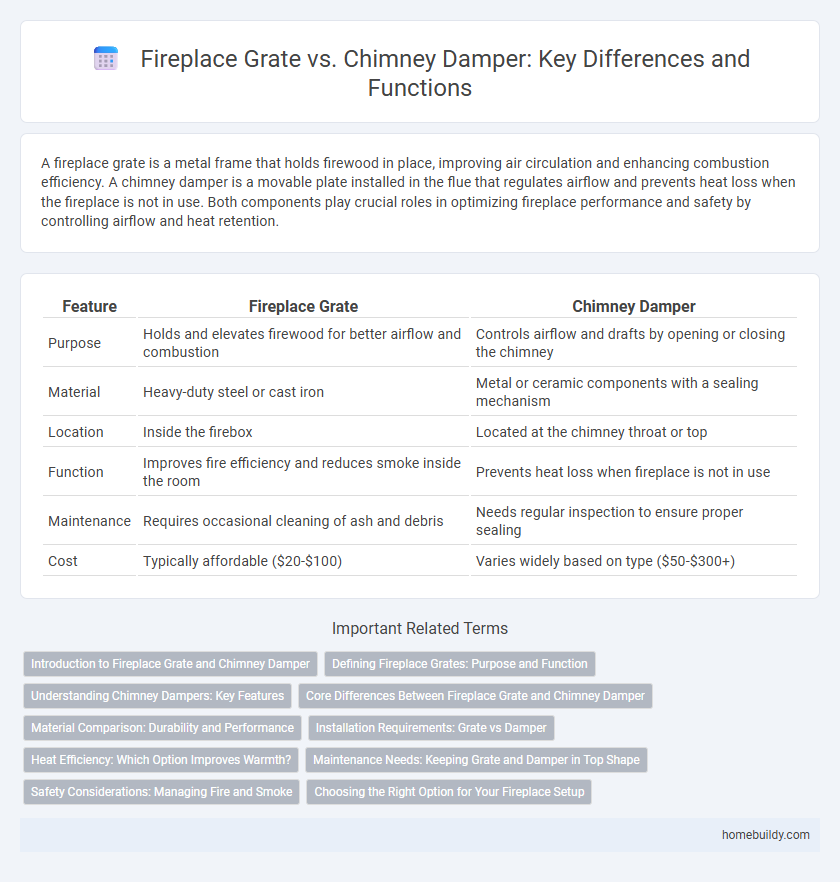A fireplace grate is a metal frame that holds firewood in place, improving air circulation and enhancing combustion efficiency. A chimney damper is a movable plate installed in the flue that regulates airflow and prevents heat loss when the fireplace is not in use. Both components play crucial roles in optimizing fireplace performance and safety by controlling airflow and heat retention.
Table of Comparison
| Feature | Fireplace Grate | Chimney Damper |
|---|---|---|
| Purpose | Holds and elevates firewood for better airflow and combustion | Controls airflow and drafts by opening or closing the chimney |
| Material | Heavy-duty steel or cast iron | Metal or ceramic components with a sealing mechanism |
| Location | Inside the firebox | Located at the chimney throat or top |
| Function | Improves fire efficiency and reduces smoke inside the room | Prevents heat loss when fireplace is not in use |
| Maintenance | Requires occasional cleaning of ash and debris | Needs regular inspection to ensure proper sealing |
| Cost | Typically affordable ($20-$100) | Varies widely based on type ($50-$300+) |
Introduction to Fireplace Grate and Chimney Damper
A fireplace grate is a metal framework designed to hold firewood securely, improving air circulation for efficient burning and heat distribution. In contrast, a chimney damper is a movable plate installed in the flue that controls airflow, preventing heat loss when the fireplace is not in use. Both components are essential for optimizing fireplace performance, with the grate enhancing combustion and the damper regulating ventilation.
Defining Fireplace Grates: Purpose and Function
A fireplace grate is a metal framework designed to hold firewood securely above the hearth, improving air circulation and combustion efficiency for a cleaner burn. Unlike a chimney damper, which controls airflow and prevents drafts when the fireplace is not in use, the grate specifically supports the firewood to maximize heat output and reduce smoke emission. This distinction highlights the grate's essential role in optimizing fire performance within the fireplace while the damper manages ventilation.
Understanding Chimney Dampers: Key Features
Chimney dampers are metal plates installed inside the chimney that regulate airflow and prevent heat loss when the fireplace is not in use. Unlike fireplace grates that hold logs to improve combustion efficiency, dampers control ventilation to optimize fuel burning and reduce drafts. Key features include adjustable designs for precise airflow control and heat retention, enhancing overall fireplace performance and energy efficiency.
Core Differences Between Fireplace Grate and Chimney Damper
A fireplace grate holds firewood off the hearth, allowing air to circulate and enhancing combustion, while a chimney damper controls airflow by opening or closing the flue to regulate smoke and heat escape. The grate improves fuel efficiency and combustion, whereas the damper minimizes heat loss when the fireplace is not in use. Together, these components optimize fireplace performance by managing fire support and ventilation separately.
Material Comparison: Durability and Performance
Fireplace grates are typically made from cast iron or steel, offering high durability and excellent heat resistance, which enhances burning efficiency by allowing better air circulation. Chimney dampers are commonly constructed from lighter gauge metal such as steel or aluminum, prioritizing airtight sealing over heat tolerance to prevent heat loss and control airflow. The sturdy material of fireplace grates withstands direct flame exposure and heavy logs, while chimney dampers balance durability with flexibility to open and close reliably without warping.
Installation Requirements: Grate vs Damper
Fireplace grates require straightforward installation, typically involving placement within the firebox without the need for structural alterations. Chimney dampers demand precise installation in the flue, often requiring professional expertise to ensure airtight sealing and proper operation. The damper's installation is more complex, impacting ventilation and draft control, whereas the grate focuses solely on fire containment and airflow within the fireplace.
Heat Efficiency: Which Option Improves Warmth?
A fireplace grate enhances heat efficiency by elevating firewood, improving airflow and combustion for more consistent and intense warmth. In contrast, a chimney damper controls heat retention by sealing the chimney when not in use, preventing heat loss and drafts. Combining a grate with a well-sealed damper maximizes heat retention and overall warmth in the room.
Maintenance Needs: Keeping Grate and Damper in Top Shape
Regular maintenance of a fireplace grate involves removing ash buildup and inspecting for warping to ensure optimal airflow and combustion efficiency. Chimney dampers require periodic cleaning to prevent creosote accumulation and mechanical checks to guarantee proper sealing and operation. Consistent care of both grate and damper enhances safety and prolongs the lifespan of the fireplace system.
Safety Considerations: Managing Fire and Smoke
A fireplace grate improves airflow by elevating firewood, promoting efficient combustion and reducing smoke buildup inside the fireplace. In contrast, a chimney damper controls airflow by opening or closing the flue, preventing smoke and gases from entering the living space while minimizing heat loss when the fireplace is not in use. Proper management of both components ensures safe fire containment, effective smoke ventilation, and protection against carbon monoxide hazards.
Choosing the Right Option for Your Fireplace Setup
A fireplace grate enhances airflow and fuel combustion by elevating logs, while a chimney damper controls airflow by opening or closing the flue to regulate smoke and heat retention. For optimal fireplace performance, installing a fireplace grate improves burning efficiency and reduces creosote buildup, whereas a chimney damper conserves energy by preventing heat loss when the fireplace is not in use. Selecting the right option depends on whether you prioritize improved combustion and safety with a grate or energy efficiency and smoke control with a damper.
Fireplace grate vs Chimney damper Infographic

 homebuildy.com
homebuildy.com